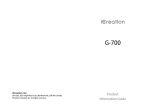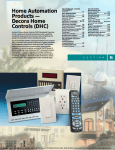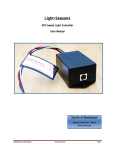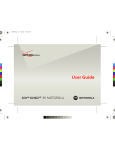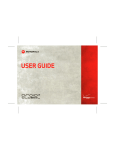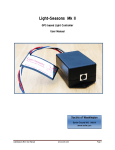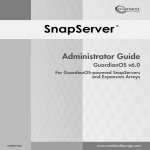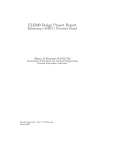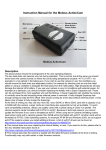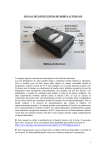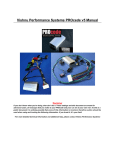Download Unifi Questions and Answers
Transcript
UNIFI Questions – Extract from Ubiquiti Forum August 2011 UniFi AP Standard UniFi AP (the standard version) uses two integrated antenna and supports 2x2 MIMO with spatial diversity. 1 passive PoE ethernet port. Maximum TX Power is 20dBm. We don't have the radiation graph available but the design targets a Dome-shaped coverage where the height is slightly shorter than radius. UniFi AP-Long Range UniFi AP-LR has the same feature/interfaces as UniFi AP but has 27 dBm maximum TX power and about 2-3 db more on RX. UniFi AP-Professional (in development) UniFi AP-Pro will have 2 GbE ports, 802.1af PoE, concurrent dual-band radio, and dualfirmware image. The product is not ready yet. Do UniFi APs require the controller to be running all the time? UniFi APs can run by themselves without the controller unless features like guest portal is enabled (as UniFi controller also functions as a captive portal). Restarting the controller won't restart your APs. Which platform(s) can UniFi controller run on? Currently UniFi can be installed on Windows and Intel Mac 10.5 and after. For Linux, we release debian packages (APT). A generic zipped package is also introduced since 1.3.2 How do I install controller on another PC/machine? The best way is to backup your original configuration (Admin->Backup), shutdown the original controller and restore it into the new controller. Your access points will be seamlessly managed by the new controller. Is there anyway to automatically backup the configurations? Here's an script that you can use: http://www.ubnt.com/forum/showpost.p...5&postcount=14 How can I run UniFi Controller on different ports 1. Make sure UniFi is not running 2. modify <unifi_base>/data/system.properties and make sure all ports needed by UniFi are available 3. restart UniFi Where are my UniFi installed (or where is the <unifi_base>)? On Mac, it's at /Applications/UniFi.app, the <unifi_base> is at /Applications/UniFi.app/Contents/Resources On Windows, it's at "%userprofile%/Ubiquiti Unifi", which is the same as <unifi_base> How do I start from scratch? (i.e. re-install the controller, re-discover the AP) In some scenarios (e.g. restarting a demo to prospective customers), you can easily press the reset button of the AP for more than 5 seconds and it will be restored to factory default. In the case where AP is inaccessible, you may SSH into the AP (with the same username/password as the controller) and issue Code: syswrapper.sh restore-default Cannot see / adopt my device anymore? What should I do? As there's a binding between controller and AP. A newly installed UniFi controller will not adopt a non-default AP. You an either: 1. use the backup feature of the original controller and restore it to the new controller 2. remove the AP (AP dialog > Config > Remove) when the AP is in Connected state. Controller will help you restore the AP to default state, then remove it from the DB. You'll see AP reboots and comes back up with amber/orange LED. AP status stucks at "adopting". What do I do? 1. 2. 3. 4. install 1.3.2 or after go through the wizard and use ubnt/ubnt as admin's username/password connect UniFi APs and laptop (with controller installed) to the same router check the router and write down the IPs of the APs. Most home routers have it listed under DHCP client table 5. SSH into each problematic AP and issue 'syswrapper.sh restore-default' If above doesn't help and your AP always show IP as 192.168.1.20. Check your DHCP server or router, if it did assign an IP to the AP yet the AP still shows 192.168.1.20, you may have a faulty AP. We've received two RMA units with a faulty RX on the ethernet port and heard a few reports on the forum. (that's why AP can send out the DHCP requests and discovery beacons but cannot get the IP assigned) To be sure, use a shorter cable and plug the AP into router/dhcp-enabled network directly. Either watch the dhcp log, sniff the packets (udp port 68), or check the dhcp lease. A change in manufacture process (where long cables were used) has also been in place for 2-3 month. How do I create floorplan images? The map accepts many common image formats like png, jpg, gif, ... (but it does NOT support .bmp) I've seen people doing all kinds of things to create the floorplans: - taking screenshots from Google Map - draw on a napkin and take picture using cellphone Overview AP discovery is done with L2 multicast/broadcast in order for controller to see it. The adoption is done by controller SSH into AP to tell the AP where the controller is. After that, it's all AP calling home to perform tasks controller asks it to do. All the AP-controller management traffic goes un-tagged. The design has L3-management in mind where you can set up controller in the clouds. Adoption Initial Handshake • When an AP is in factory default (LED shows steady amber/orange), it will obtain IP from DHCP server and send out beacons - "I'm in factory default. Who can manage me?" • Controller hears the beacon. As this device is in default state, shows the AP as PENDING. • When the user decides to adopt the AP, controller will adopt the AP via SSH (using the IP information in the beacon and the default username/password) • AP sends initial inform to http://controller_ip:8080/inform, the binding of controllerAP is now completed When the AP was already adopted • When an AP has been adopted (LED shows steady green) but the controller is not present, the AP sends a slightly different beacon - "I'm here. When you (the controller) are up/ready. Come pick me up." • When the original controller comes up, it hears the AP's beacon and finds that the AP is under its management. It will readopt the AP automatically via SSH (using the IP information in the beacon and with the non-default credential). So here's what got most people - all APs were adopted and have green LED. The user tries to install a new controller and the controller cannot see any of the APs In the release 2.0, we'll show those APs as "Managed by Others" and provide you "advanced adoption". In the mean time, we suggest you follow follow instructions in "Cannot adopt my device anymore? What should I do?" above in Deployment Guide section. Management Controller manages AP using a proprietary TR-069-like management protocol. The main idea, for scalability, is for AP to phone home periodically via L3. And to support instant notifications from controller->AP, STUN is also used. Yes, the protocol is encrypted. Can I put the controller in a different subnet? We'll have a thought-through support in Release 2.0.0 but it's doable in 1.x.x: Suggested approach: 1. place UniFi controller in the desired subnet, you need to give it static IP (or statically assigned-IP through DHCP) 2. place APs in the same L2 so they're adopted 3. move APs to their desired subnets 4. as APs know where the controller is, they'll phone home Alternative approach: (SSH required) 1. have UniFi controller adopted the APs 2. move the UniFi controller to another subnet (again, you want to make sure the IP is static) 3. modify /etc/persistent/cfg/mgmt so it points to the correct IP 4. do 'syswrapper.sh save-config' 5. do 'reboot' Either way, two crucial things: 1. controller adopts the AP 2. the AP knows where the controller is UniFi - Guest Access Overview We understand guest access is an important part of wireless system offering. In release 1.x, we're targeting a few groups of users. In release 2.x, we'll provide a customizable guest portal with billing system integrated. Here are the targeted scenarios for 1.x: I just want to provide free and simple guest access Recommendation: In Wireless Configuration, enable "Apply Access Policies". This turns on guest isolation and subnet restrictions (which can be customized in Settings>Guest Control), etc. - making sure guest cannot access your corporate network. If you choose Open for security, it's pretty much a connect-and-go, no guest portal, no "Terms of Use" or anything. UniFi controller doesn't even have to be running! You still have the option to choose WPA-Personal - just need to have a way to tell the guests the Passphrase. I think I need to show "Terms of Use"... just to play safe Recommendation: In Wireless Configuration, enable "Apply Access Policies". In Settings-> Guest Control, enable Guest Portal and choose "No authentication". Enabling "Guest Portal" puts the guest in a walled garden. In plain English, the connected guest can get an IP, do DNS lookup; however, all other traffic is blocked. The HTTP/HTTPS traffic will be redirected to the guest portal (in this case, the UniFi controller). This works very much like what you usually see in Starbucks or Airports. You connect to a open wireless network, open a browser and go to www.google.com, gets redirected, accepts Terms of Use, and you go! You may get redirected to a Promotional URL or the original URL you intended. Moreover, you get a few hours of free access depending on the operators' policies. * After 1.3.2, you also have the option of specifying the Expiration time. After the 'authorization' expires, the guest will be prompted with the Guest Portal again. I don't want just anyone to get in. How do I limit the access? Recommendation: In Wireless Configuration, enable "Apply Access Policies". In Settings-> Guest Control, enable Guest Portal and choose "Simple Password". When the guest is prompted with the guest portal, s/he will not only need to accept the Terms of Use but provide a password. There's nothing fancy/flexible but we see this is a quick-and-easy way. Another way is to use WPA-Personal and disable guest portal all together as you need to tell the guests a password anyway. I need to customize the portal page and use my own way to authorize the user (e.g. making the user pay) Recommendation: In Wireless Configuration, enable "Apply Access Policies". In Settings-> Guest Control, enable Guest Portal and choose "External Portal Server". Then take a look at portal_sample.zip. Out of the gate we know our guest portal feature is limited. External Portal Server is for advanced integrators who can install/program their portal web server. UniFi will set up the policies so guests will be redirected to the specified External Portal Server (traffic-wise, port 80 and 443 will be forwarded). An API is provided to tell the controller something like "authorize guest[00:15:34:93:e3:f2] for 4 hours". UniFi controller will take it from here. I already have my own L3 implementations for this Recommendation: well... some may opt to use UniFi AP to serve WiFi and have their own walled-garden/guest portal implementation already. I believe this folks know what they're doing. VLAN It's more than natural to think of VLAN when guest access is mentioned. However, there are a few technical details to talk about. Let's start with the basic VLAN deployment where guest portal is not enabled: Code: 1. UniFi AP tags wlan->wire traffic 2. AP-controller is untagged 3. controller is likely running on untagged interface 4. configured inside the AP: guest --- br0.3 --- eth0.3 --3--+ br0 ------------------+--u,3---port1 corp -----+ Deployment example: • port8 connecting to router's DMZ port, add port8 as member of vlan3 and untagging. enable DHCP server on your DMZ • port5 connecting to internal network, have port5 untagged. What happens when Guest portal enabled with VLAN (NOTE: As of 1.3.2, guest portal doesn't work when VLAN is enabled, will investigate and fix) When guest portal is enabled, the controller acts as a portal server and the guests will be redirected to http://unifi_ip:unifi_http_portal_port/guest/. This is where where issues come from - guest is on vlan3, bridged to DMZ, there's no way it can reach unifi_ip:unifi_http_portal_port. In the scenario above, one solution to the problem is to add rules to your router 1. add route for traffic from DMZ->unifi_ip 2. allow DMZ->unifi_ip:unifi_http_portal_port Another solution, where we envision this moving up in scale, is to have the controller running at NOC or cloud. How much ssid and vlan supported 4 SSIDs (and corresponding VLAN IDs) How does vlan traffic get tagged? UniFi AP tags packets when it goes out from WLAN to wire. When tagged traffic comes in from the wire, it will untag it and forward it to WLAN. How do I use WPA-Enterprise? Usually this involves • set up RADIUS server (Windows IAS, FreeRADIUS, etc) • tell RADIUS server where the RADIUS request may come from (i.e. the IP address/subnet/range of the APs) • set up wireless clients with configuration and, if necessary, certificates (e.g. EAPTLS) You can configure the type of EAP you'd like to use and UniFi APs do not get involved. How do I configure WPA1 / WPA2 By default, when WPA is used, UniFi will enable WPA1/WPA2 (or mixed mode) as well as TKIP/CCMP(AES). Release 2.0 will enable you to limit/force specific security settings. Do you support roaming? Yes. Roaming is supported per 802.11. UniFi doesn't do anything to assist or influence the station's roaming decision. In our testing using WPA-PSK, we send flood ping from the laptop to a PC on the wired side: - from the last ping to the original AP until association completion to the new AP is 45155ms - from the last ping to the original AP until the first ping to the new AP is ~ 1s For most internet applications, it should be seamless. For VoIP, observable delays may be noticed. Do you support WMM? Yes, and WiFi-certified. Why do I never see 300Mbps even if HT40 is enabled? I don't want to bore you with technical details but check the Data Rates Table here. UniFi APs are capable of 300Mbps _if_ the client can and want to use it. Here are common numbers you can see (all assuming good signal) - 65Mbps (client only has 1 receiving antenna, MCS7) - 130Mbps/144Mbps (client has 2 receiving antenna, MCS15. 40Mhz not supported or disabled) * Macbook does have multiple antennas; however, it only supports HT20 on 2.4Ghz and by default enables HT40 on 5Ghz Do you support auto channel selection? By default AP will find a best channel when it powers up. You can overwrite it in the per-AP config. Background-scanning and automatic runtime channel change is on the road map. What's the maximum number of clients can an AP support This is a question that's hard to answer. The implementation supports 100+ client simultaneously but in reality it depends on what these clients do (just email/web/chats? streaming? downloading?) In our office, we constantly have 20+ (30+ at times) various kind of devices without any issues. We had reports about problems with more than 60 clients but haven't reproduced it yet. Currently in our lab, we have ~100 clients stressing one AP. What mobile devices have you tested? We recognised that mobile devices in a wireless network is a big thing and we've been constantly working on testing and fixing issues. In our lab, we had iPads, iPod 3G/4G's, Andriod phones (HTC Desire, DesireHD, Driod X). People also bring their mobile devices to connect our UniFi wireless networks: iPhones (all generations), iPads, Android (Samsung GalaxyS, i9000, Epic, Motorola Driod, Droid2...), and Andriod tablets (Galaxy Tab)







